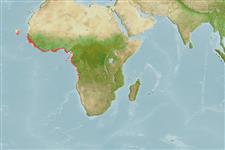>
Carangiformes (Jacks) >
Carangidae (Jacks and pompanos) > Caranginae
Etymology: Caranx: French, carangue, the name of a Caribbean fish; 1836 (Ref. 45335).
More on author: Cuvier.
Environment: milieu / climate zone / depth range / distribution range
Ecologia
marinhas; estuarina bentopelágico; intervalo de profundidade ? - 200 m (Ref. 26999), usually ? - 100 m (Ref. 26999). Tropical; 25°N - 20°S
Eastern Atlantic: west coast of Africa, from Mauritania to Southern Angola (Ref. 57392).
Comprimento de primeira maturação / Tamanho / Peso / Idade
Maturity: Lm 21.0 range ? - ? cm
Max length : 100.0 cm TL macho/indeterminado; (Ref. 26999); common length : 50.0 cm TL macho/indeterminado; (Ref. 26999)
Espinhos dorsais (total): 9; Raios dorsais (total): 20-21; Espinhos anais 3; Raios anais : 17 - 18. Diagnosis: body elongate (depth comprised 2.4-3.2 times in fork length); head ogival; snout slightly pointed; end of upper jaw extending to below centre of eye; 2 dorsal fins, 1st with 8 spines, 2nd with 1 spine and 20-21 soft rays; anal fin with 2 spines, followed by 1 spine and 17-18 soft rays; anterior lobes of dorsal and anal fins strongly developed, falciform, longer than head; pectoral fins falcate, longer than head; scales small and cycloid (Ref. 57392). Chest entirely scaleless (Ref. 57392, 81654). Posterior (straight) part of lateral line with 40-45 scutes; bilateral caudal keels present (Ref. 57392).
Coloration: back bluish-grey, sides and belly silvery-white to yellowish; in adults, vertical fins grey, other fins colourless; in juveniles, anal and caudal fins yellowish (Ref. 57392).
Inhabits coastal waters (Ref. 2683). Pelagic species that may enter estuaries and lagoons (Ref. 57391). Feeds on fish, crabs and shrimps (Ref. 28587). Maximum total length reported as 500mm in Ref. 57392.
Ciclo de vida ou comportamento de acasalamento
Maturidade | Reprodução | Desova | Ovos | Fecundidade | Larvas
Smith-Vaniz, W.F. and F.H. Berry, 1981. Carangidae. In W. Fischer, G. Bianchi and W.B. Scott (eds.) FAO species identification sheets for fishery purposes. Eastern Central Atlantic (fishing areas 34, 47 (in part) . Vol. 1. (Ref. 3195)
Status na Lista Vermelha da UICN (Ref. 130435)
Ameaça para os humanos
Harmless
Uso pelos humanos
Pescarias: pouco comercial
Mais informação
ReferênciasAquaculturaPerfil para aquaculturaEstirpesGenéticaElectrophoresesHereditariedadeDoençasProcessamentoNutrientsConversão de massa
Ferramentas
Relatórios especiais
Baixar XML
Fontes da internet
Estimates based on models
Preferred temperature (Ref.
123201): 16.1 - 25.8, mean 19.7 °C (based on 66 cells).
Índice de diversidade filogenética (Ref.
82804): PD
50 = 0.5000 [Uniqueness, from 0.5 = low to 2.0 = high].
Bayesian length-weight: a=0.01738 (0.00796 - 0.03794), b=2.94 (2.77 - 3.11), in cm total length, based on LWR estimates for this Genus-body shape (Ref.
93245).
Nível Trófico (Ref.
69278): 3.9 ±0.67 se; based on food items.
Generation time: 2.4 ( na - na) years. Estimated as median ln(3)/K based on 1
growth studies.
Resiliência (Ref.
120179): Elevada, tempo mínimo de duplicação da população menor que 15 meses (Preliminary K or Fecundity.).
Fishing Vulnerability (Ref.
59153): Moderate vulnerability (35 of 100).
Nutrients (Ref.
124155): Calcium = 32 [15, 94] mg/100g; Iron = 0.443 [0.227, 0.908] mg/100g; Protein = 18.8 [16.4, 21.3] %; Omega3 = 0.214 [0.103, 0.454] g/100g; Selenium = 97.6 [42.2, 213.5] μg/100g; VitaminA = 17 [5, 44] μg/100g; Zinc = 0.62 [0.40, 0.98] mg/100g (wet weight);
